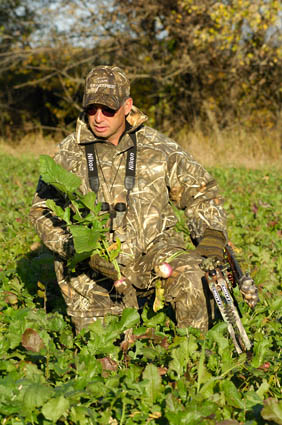Food And Habitat
 Less than 100 years ago, deer were rare in the South. The elimination of widespread poaching, an increase in agriculture, and the restocking of whitetails from out of the area have brought the South to deer prominence today. It’s largely believed by many biologists and hunters that mass stocking of northern whitetails from Virginia, Wisconsin, and other states influenced buck rutting periods in the deer, which has resulted in a hodgepodge of times for swollen whitetail necks throughout the region. Cross-breeding between stocked deer and native animals also has complicated the breeding season, say some savvy scientific deer researchers.
Less than 100 years ago, deer were rare in the South. The elimination of widespread poaching, an increase in agriculture, and the restocking of whitetails from out of the area have brought the South to deer prominence today. It’s largely believed by many biologists and hunters that mass stocking of northern whitetails from Virginia, Wisconsin, and other states influenced buck rutting periods in the deer, which has resulted in a hodgepodge of times for swollen whitetail necks throughout the region. Cross-breeding between stocked deer and native animals also has complicated the breeding season, say some savvy scientific deer researchers.
Yet another curveball thrown into the Dixie deer rut is the availability and quality of food that animals ingest.
“Undernourished animals often breed later in the season than deer with proper nutrition,” explains Urbstron. “If deer are severely malnourished, they might not even breed at all. This is important these days, since some southern regions are having severe drought, or too much rain, both of which can have an effect on deer browse and woods mast. Failed farm crops can have an impact, too.”
It sounds crazy, but Urbston says there have been cases of wild deer not breeding because they were over-nourished. They were, in his words, simply too fat to mate. Excessive fat can interact with the ability of an animal to breed, he explains.
“Hot weather, like much of the South has had the last few years, also impacts the rut,” Urbston continues. “If we have unseasonably hot, dry weather during the peak rut, you can bet bucks aren’t going to be chasing does through the woods trying to mate. Weather and temperature have a great deal to do with rut activity.”
The Photoperiod Theory
“Factoring into all these vague ingredients of the Southern rut is the so-called ‘photoperiod,’ which a lot of deer researchers believe is the most important part of all,” adds Urbston.
The photoperiod is a biological hypothesis that claims that the shorter days of fall and winter (usually less than 12 hours of daylight) prepare a doe for estrus. The “trigger” according to the photo theory, is moonlight. The moon is brightest during the second and third full moons following the fall equinox. This jumpstarts doe estrus, which brings bucks into full rut. It’s easy to discount the photo theory as a lot of mumbo-jumbo, but plenty of learned deer researchers take stock in it. And there are many reasons why hunters should, too.
However, while the photo period is important to the Southern rut, so are all the other factors discussed here — including genetics through deer restocking, environmental factors, food and, of course, weather.
So what’s the bottom line?
Basically, the Southern whitetail rut is vastly different than the rut in the North, and it’s very regionalized. Hunters should carefully check with state game biologists and local area sportsmen before trying to time trips with the Dixie rut. Follow your own instincts, too.
On my deer lease in middle Georgia, for example, the rut rocks sometime between the last week of October and the second week in November. I hunt as often as possible during that period. And when conditions are perfect, I make certain I’m hunting. Any time the weather is clear, cold and calm during those three weeks in my hunt area, almost nothing can keep me out of the woods. But southwest of there, in the Florida panhandle, I hunt another tract during the cold, bright, calm days of mid-February — when whitetails there are wide-eyed and rutting.
In the South, as in real estate, the rule is location, location, location — the most important ingredient for successful rut hunting.
So learn the best general time of the rut in the South region you hunt. Then get in the woods often, and make sure you’re on stand when weather conditions are perfect.
Piece of cake, right?






